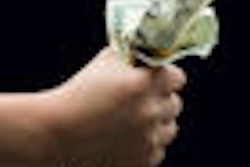
When Matthew Comfort, D.D.S., balanced his books this winter, he got a shock: Receipts had dipped 20 percent. Dr. Comfort quickly realized that his Rocklin, Calif. practice was falling with the slide in the U.S. economy, and he had to take action. Moving swiftly, he condensed his appointment schedule to four eight-hour days to spend more time in the local hospital emergency room, where he offers dental trauma services. He cut expenses wherever he could. He even asked suppliers for a discount.
As a result, he's sure he'll survive this recession. He may even come out ahead because the hard times have made him look so closely at how he runs his business. "This is another opportunity to get the office fine-tuned," he says.
Dr. Comfort is not alone. Signs are emerging that the tough times will hit dentistry. Not everyone can benefit from the same solutions that worked for Dr. Comfort. But by looking closely at the way they work, dentists can discover multiple paths to averting disaster. Many may find it more important than ever to treat their practices like businesses -- improving efficiency, advertising strategies, and customer satisfaction. New technologies can also boost the bottom line. Finally dentists can demonstrate to patients that dental care is an essential need rather than a luxury.
Though the long-term economic outlook remains foggy, the Robert W. Baird securities firm concluded this month that "a slowdown is truly underway" in dentistry. "Appointment cancellations are up, patient traffic is down, and patients are increasingly pushing back on higher-end dental treatments," the firm reported, after surveying 245 dental offices in early spring.
So far, the recession seems to have hit specialists the hardest, says Irvin G. Lubis, D.M.D., a former Boonton, N.J. periodontist who now works as a marketing consultant for dentists. That’s because they get fewer referrals from general dentists in tough economic times. Three periodontists in Westchester County, N.Y., recently went out of business, he says.
"When things get slower, you want to advertise more."
But generalists are feeling the pinch as well. Richard Gochman, D.D.S., a general dentist in Flushing, N.Y., says some patients are refusing to finish dental work that’s half done. Other patients won’t even consider payment plans these days, even if they are interest-free for a year, because they want more control over their financial lives, he says. An increasing number of patients, meanwhile, are being denied credit so financing is not even an option, a dentist who participated in Baird’s survey says.
Cut your costs
Despite the grim news, dentists don’t need to panic, practice management experts say. They simply need to apply sound business principles -- principles that will help them weather any financial crises and improve their bottom lines for decades to come.
To start with, most dentists waste time and money, says Bill Blatchford, D.D.S. who heads Blatchford Solutions in Bend, Ore. "Dentistry has never had to be efficient," Dr. Blatchford says. But when the economy slows, inefficiency causes more problems than ever. The typical dentist has an overhead of 75 percent, Dr. Blatchford says. With such a high overhead, a 10 percent drop in gross receipts translates to a 40 decrease in net income. Cut your overhead to 50 percent, and a 10 percent slowdown only becomes a 20 decrease in net.
So, how to cut overhead?
In most offices, dentists’ biggest business mistake is overstaffing, says Dr. Blatchford. If something goes wrong, he says, "dentists throw more people at the problem." Instead, carefully analyze the problem, and look at other possible solutions.
In many cases, technology can replace the need for staff time. For example, dentists should aim for paperless offices, which can eliminate endless hours of filing.
In other cases, hygienists can do some of the work of office managers. Even making smaller changes, like having hygienists collect money from patients after cleanings, can make a huge difference. Not only does that stop the office from wasting time billing the patient, but it gets the patient’s money into the dentist’s bank account faster, increasing the amount of interest on money earned from the appointment.
Hygienists should also encourage patients to book their next visits before leaving the office, says Nathan Kaufman, D.D.S. a dentist in Albany, Calif. That way, follow-up phone calls are perceived as appointment reminders rather than business solicitations. "It’s helpful rather than promotional," he says.
Market your practice
But dentists shouldn't shy away from promoting themselves, consultants warn.
Advertising is especially critical during lean times. "When things get slower, you want to advertise more," says Dr. Lubis, noting that a lot of companies have not figured this out.
Advertising doesn't have to mean an expensive newspaper or television campaign, though. Sometimes inexpensive promotions can be much more cost-effective.
Dr. Gochman, who began marketing online only 16 months ago, says the Web is his only profitable advertising tool these days. After he landed his first $9,000 case from his Web site, “it made me a believer,” he says. It can offer you a competitive advantage, too, since only a third of dentists have a Web site according to Dr. Lubis.
Among the other low-cost marketing techniques:
- Recording ads on your phone lines, which patients can hear when they are put on hold.
- Giving out treats such as homemade cookies -- or sugarless gum -- at the end of appointments.
- Raffles for patients.
- Social activities. One Virginia orthodontist organizes ice skating parties during the winter.
- An office pet. Nick Duncan, D.D.S., a dentist who practices near Lake Tahoe, Calif., has a dog in his office. "People come in just to see the dog," he says, even when they don’t have appointments.
- Sprucing up the office. A coat of paint and a vase of fresh flowers in the waiting room can go a long way.
Sell your services
Getting patients into the office is only the first step of the marketing process. Dentists may have to pitch their treatment plans differently in times of economic stress.
One key is persuading patients that if they let problems fester, they will pay more later. Dr. Blatchford suggests politely questioning patients who decline work because of the economy. Some may be resisting treatment out of fear of hardship rather than actual hardship. "Most people really aren’t affected by the economy," he says. "It’s all perception." For example, only 4 percent of people who have mortgages are in foreclosure, he notes.
New technology can help make the sale, as well, says Richard Geller, a dental marketing expert in McLean, Va. A diagnostic laser can detect hidden decay, he says, while a better intraoral camera might convince patients to get more work done.
"My strategy is to provide more services," Dr. Duncan says. He not only invested in new equipment but in continuing education. After taking dozens of hours of classes, he now places implants and invisible orthodontics in addition to doing his general dental work.
"It keeps the patient in the practice," he says. And it wins their loyalty because patients like having the work done by the dentist they already know.
Dentists should also enlist their staffs to sell procedures, Geller says. After all, hygienists and dental assistants often spend more time with patients than dentists do. In particular, they can make the pitch for soft tissue management. A large percentage of patients suffer from some sort of periodontal disease, which can best be treated with multiple office visits.
Cosmetics will be harder to sell in a down economy, but not impossible, Dr. Blatchford insists, noting that Revlon became a successful cosmetics company during the Depression. "No matter how little money people have, they want to look good."
Dr. Kaufman, on the other hand, thinks dentists should focus on new preventative techniques. "You really want to do your core values as well as you can," he says. "There’s an opportunity to better take care of people with services not provided before." Less than 1 percent of dentists measure salivary bacteria levels and only 34 percent apply in-office fluoride varnishes, according to a survey that Dr. Kaufman and his colleagues will present at the International Association for Dental Research convention in July. Yet these approaches can be good for both the patient and the dentist's bottom line.
A growing number of insurance companies will reimburse new preventative techniques, including more frequent visits for high-risk patients. And dentists can present them as a way to cut the cost (as well as the pain) of infection and decay. "Patients see a dental office completely differently, when all of a sudden they perceive you’re treating them for a disease," Dr. Kaufman says. As a result, they become more loyal and more likely to accept your recommendations.
If dentists want to expand services, "why wouldn’t you treat the disease you’re the expert on?" he asked. "This is our turf."



















